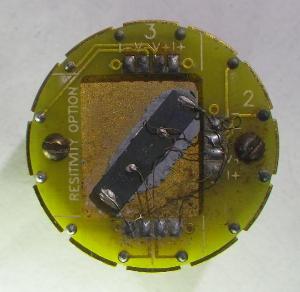Oct 30 2014
Researchers at the California Institute of Technology (Caltech) have developed a new technique to analyze multi-phase electrical properties of thermoelectric materials. They have found that combining various solid phases could improve the performance of thermoelectric materials.
 Researchers at Caltech devised a way to calculate the electrical properties of individual components of a composite material by testing the material's response in a range of magnetic fields. This image shows the material wired in a sample holder designed to measure its electrical properties. Credit: Tristan Day/Caltech
Researchers at Caltech devised a way to calculate the electrical properties of individual components of a composite material by testing the material's response in a range of magnetic fields. This image shows the material wired in a sample holder designed to measure its electrical properties. Credit: Tristan Day/Caltech
Thermoelectric materials possess the ability to convert electricity into heat, as well as heat into electricity. Pure phase properties cannot be measured directly because pure components of multi-phase materials cannot be produced easily.
The researchers found a new method for calculating the electrical properties of the individual phases of the material. They applied a modified version of the “effective medium theory.” They took into consideration a composite material and then for each constituent phase, they backed-out its properties.
The team studied the thermoelectric material, Cu1.97 Ag0.03Se that had Cu2Se as main crystal structure and CuAgSe as impurity phase crystal structure. Each part of composite thermoelectric materials responds to magnetic fields in a specific manner. The team was able to distinguish between the affect of different phases, by measuring electrical properties over various magnetic field strengths.
Thermoelectric materials are used in air-conditioned car seats, medical refrigerators and other applications. As they do not have any moving parts they are better than other cooling mechanisms. When compared to compressor-based cooling systems, thermoelectric materials consume about 3 times more energy for delivering the same cooling.
However, their versatility and their small size could allow their usage for smart ways to reduce energy consumption. Thermoelectric-based heaters or coolers placed in car seats or steering wheels could provide the desired comfort for the driver without changing the temperature of the vehicle’s cabin.
The usage of the correct material structures and combinations could improve the energy efficiency of thermoelectric materials. The new calculation methods developed by the researchers could help find this combination.
This calculation involves making classical assumptions, and differences between the actual properties and the calculations ascertain nanoscale effects. Micro- and nano-scale structures generate quantum effects that improve the performance of thermoelectric materials.
The researchers have published this study in the journal Applied Physics Letters.